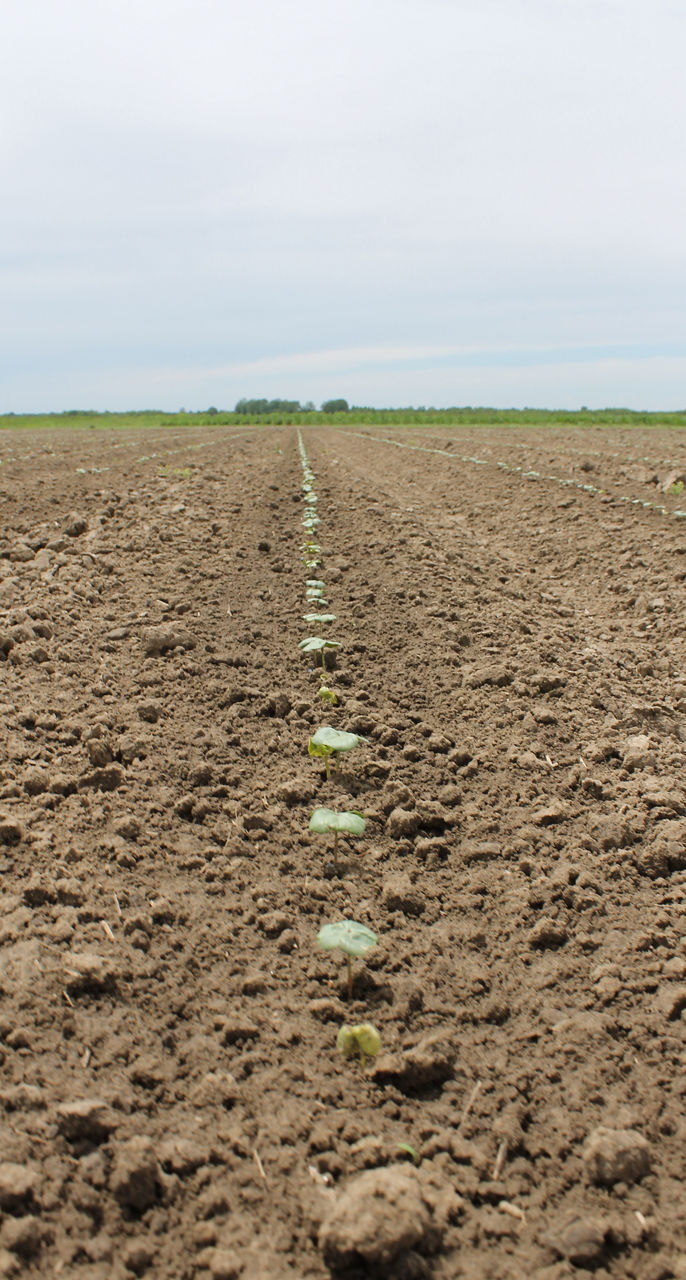3 MIN READ
How Do High Soil Temperatures Influence Cotton Germination?
July 19, 2021
Crop yield responses to temperature vary widely, depending on crop species, cultivar, soil conditions, and weather conditions. Cotton growers have many environmental variables to contend with such as: temperature, timing of rain and intensity, cultural practices, soil type and cotton product characteristics. Therefore, understanding crop responses to temperature are vital in the decision-making process.

Why should I be concerned about the impacts of higher temperatures on cotton germination?
Weather is one of the most important factors that affects crop growth and yield potential. Seedling establishment is strongly influenced by soil temperature. Below-optimum temperatures can delay cotton growth and favor pest development. Above optimum temperatures at planting, although unusual, can cause substantial challenges for stand establishment. Planting in hot, dry conditions without adequate soil moisture in the furrow can result in reduced or failed stands which can translate to reduced yield potential and replanting.
A study conducted by the U.S. Department of Agriculture over a 10-day period found there was no measurable development of cotton lateral roots in soil temperatures below 68°F. Lateral root development began to decrease at temperatures of 93˚F, and minimal root development occurred at 104˚F, the maximum temperature tested.1
Most research emphasis has been on the low temperature limits for germination because cotton is planted during spring when low soil temperatures are a major hazard. A study conducted in 2011 found that the optimal temperature zone for cotton germination was 82°F to 86°F. As temperature decreased from the optimal zone, the germination rate decreased but percentage germination during the 10-day period was significantly lower only below 68°F. As the temperature increased above the optimal zone, the germination rate decreased, and the percentage germination sharply decreased above 89°F to 93°F.2
What is the ideal soil temperature range for cotton germination?
Cotton seed germination is favored by high soil oxygen concentration, adequate moisture, and soil temperatures above 64°F.3 Temperatures above 64°F in the seed zone can require more than 100 hours for cotton seed to emerge. The optimal planting target is to have a 10-day average soil temperature of 65°F at the 8-inch depth. At a minimum, soil temperatures in the seed and root zone should exceed 60°F and the five-day forecast for daytime maximum temperatures should be above 50°F. Emergence will generally occur after accumulation of 50 to 80 growing degree days (GDD) after planting.
How do soil temperatures at planting and soon thereafter influence seedling vigor?
Seed germination, emergence, and early season vigor are important aspects of cotton development, which play an important role in early season canopy development and light interception. The first two to four days after planting is when the radicle (tiny root) begins to emerge from the seed, with warm temperatures leading to a more rapid emergence. The adverse effect of cool temperatures during this period is cumulative, and yield reduction can be related to chilling hours below 50°F. Injury at this stage affects the emerging seedlings’ capacity to manufacture proteins, which can reduce yield potential.4
Typically cotton growers are waiting for soil temperatures to increase; however, there may be circumstances within the planting window with exceptionally high soil temperatures. In general, waiting for optimal soil temperatures can lead to more uniform stands and fewer replants. Late planted cotton may require more aggressive growth management with plant growth regulator (PGR) applications, especially with more aggressive cotton products.
What are the management options for high heat soils at planting?
Any management tools that help decrease soil temperature may help prevent stand loss in a high soil temperature environment. Cover crops, conservation tillage, and pre-watering the field prior to planting may be able to help cool soils to reduce the impact of high heat on the stand. However, it may be best to wait to plant until conditions improve.6
What should I consider if I can’t wait to plant?
Planting cotton into dry soils, or dusting into soils, with preemergence (PRE) herbicides applied can result in high crop injury. Soils that have been watered in prior to planting can help limit the amount of damage to emerging seedlings. To help limit potential damage, the cotton roots need to grow faster than the PRE herbicide moves through the soil. Cotton seed that is planted into dry soils followed by a PRE herbicide is more susceptible to damage because when water is applied it will carry the PRE herbicide with it, increasing potential for damage (Figure 1).

Dusting in cotton without a PRE herbicide can help avoid potential damage. However, this requires a high level of management. Fields should be weed-free prior to planting. Apply the first postemergence (POST) herbicide as soon as the cotton has emerged. This application should kill any emerged weeds and include a residual herbicide. Apply a second POST herbicide 12 to 15 days later with a residual herbicide. Layby applications may be necessary for fields without a PRE herbicide to help control tough weeds like Palmer amaranth.6
Sources:
1 McMichael, B.L. and Burke, J.J. 1994. Metabolic activity of cotton roots in response to temperature. Environmental and Experimental Botany. Vol 34, No 2, pp 201-206.
2 Krzyanowski, F.C. and Delouche, J.C. 2011. Germination of cotton seed in relation to temperature. Revista Brasileirade Simentes, Vol 33, No 3, p 543-548.
3 Boman, R. and Lemon, R. 2005. Soil temperatures for cotton planting. SCS-2005-17. AgriLife Extension. Texas A &M University. http://cotton.tamu.edu.
4 Reddy, K.R., Brand, D., Wijewardana, C., and Gao, W. 2017. Temperature effects on cotton seedling emergence, growth, and development. Biometry, Modeling, and Statistics. Agronomy J. 109:1379-1387.
5 Reddy, K.R., Hodges, H.F., McCarty, W.H., and McKinion, J.M. 1996. Weather and cotton growth: present and future. Bulletin 1061. Mississippi Agricultural and Forestry Experiment Station. http://mafes.msstate.edu.
6 Culpepper, Stanley. 2021. Herbicides and dusting in cotton can be a mighty challenge. The University of Georgia.
3015_S1